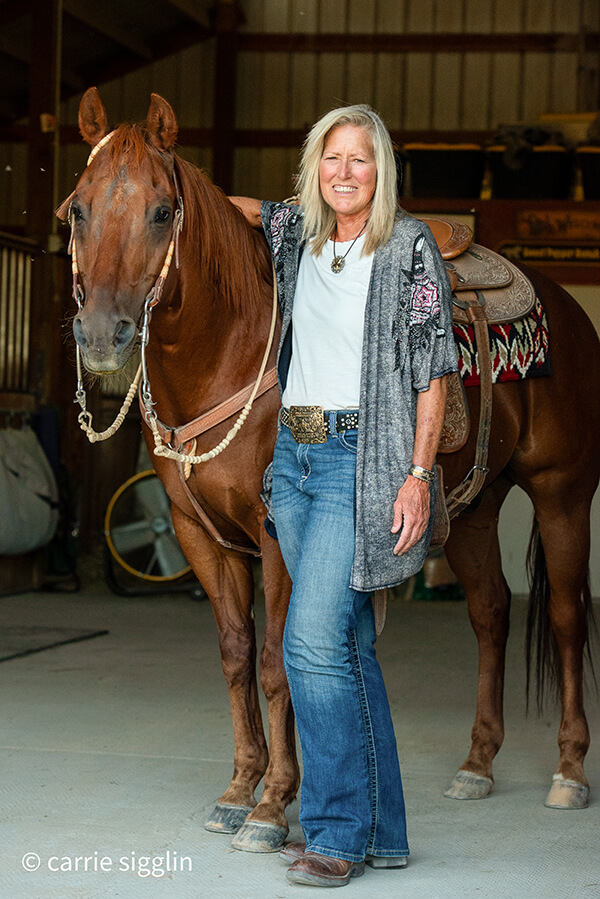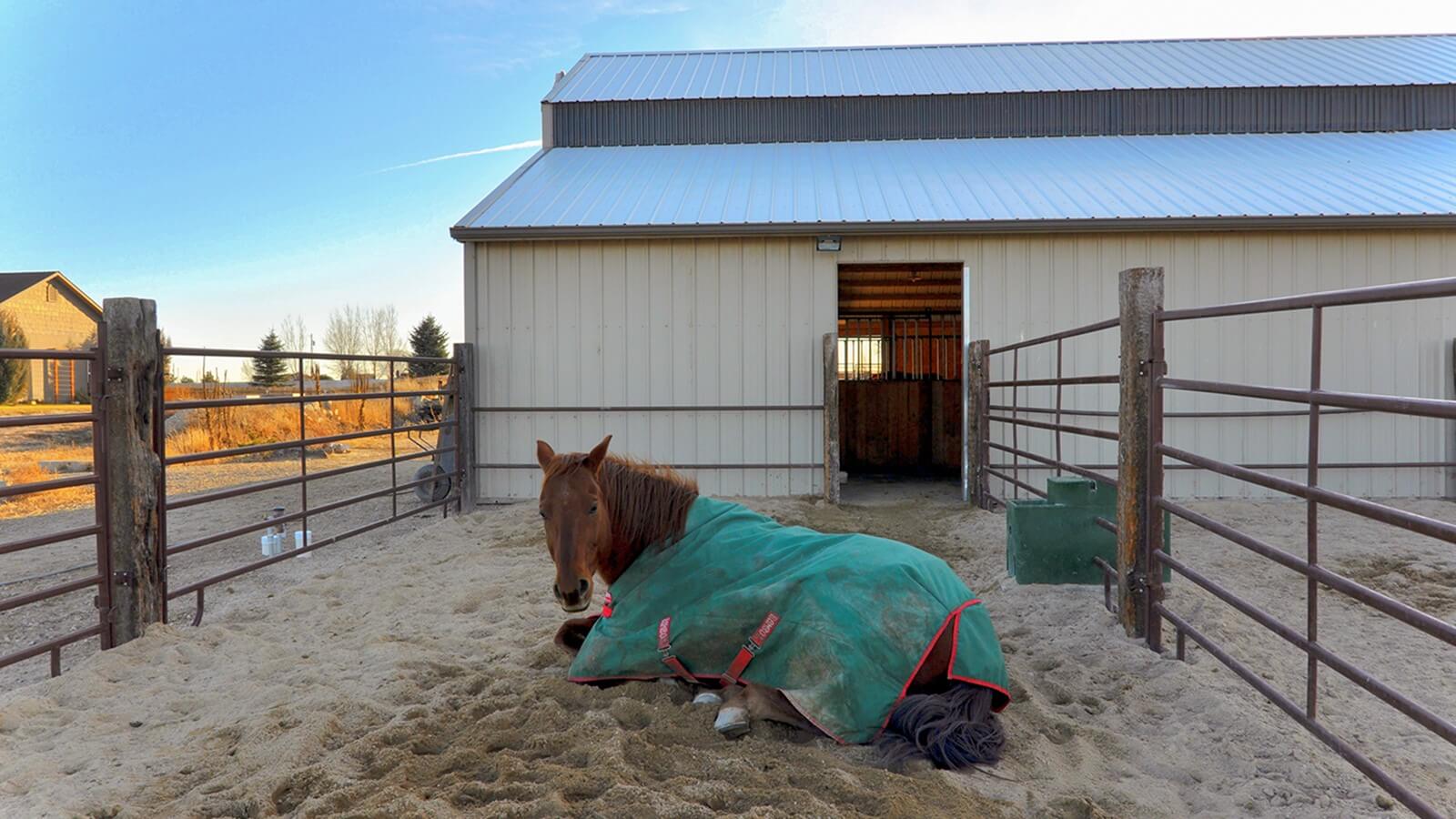The dead of winter usually comes with footing challenges for horse owners. It’s unhealthy for horses to stand in disease-causing muck and it’s difficult to get chores done when pushing a manure cart through ankle-deep mud. Plus, there are detrimental implications for the natural world around us since dirty water runoff pollutes streams and water bodies.
Footing material is useful for paddocks, confinement areas, and other high-traffic areas such as gates or watering points. The purpose of a footing material is to build up an area to keep your horse out of mud. Doing this allows surface water to drain and decreases erosion – all good for horse health, chore efficiency, neighborhood esthetics, and for environmental health.
Three main categories of footing options exist, each with their own pluses and minuses:
Hog fuel, available in some parts of the country, is made from ground cedar, fir, or pine stumps or branches. The natural composting process of wood contributes to the breakdown of the nitrogen in the horse’s urine and manure, reducing odors and keeping harmful pollutants from being released into the ecosystem. A downside of hog fuel is it decomposes over time which leads to an eventual build-up of decomposed wood chips and more mud. Tree trimmings are not recommended as a footing for horses since many types of trees (including greens) are toxic to horses and may lead to serious gastric problems.
Gravel, or crushed rock, is an excellent choice. Gravel sized between 3/8 and 5/8-inch works well for horses to stand on and it’s easy to pick manure from this surface since gravel easily slips between the tines of a manure fork. Gravel products are the best option for wet climates. Gravel sized larger than 5/8 inch is usually uncomfortable for a horse to stand or lie on and may be difficult for manure pick-up.
Sand is a long-standing, traditionally used horse footing. Coarse, washed arena sand is optimal and the least dusty. Sand is by far the easiest footing for chore efficiency and manure clean up, plus horses love to roll and sleep on sand. Drawbacks include that sand drains poorly (a consideration for wet climates) and can be quite dusty in summer months (a concern for arid, windy climates). Sand tends to migrate with slope and will track inside a stall on rainy days (a drawback for wet climates). A serious health consideration for sand is that horses fed on this surface can ingest sand particles leading to sand colic and serious horse health issues; sweep stall mats before each feeding to be sure they are clean and sand-free.
The type of footing you choose depends on these factors:
- Availability
- Cost
- Wood chip products decompose over time which means eventually the small, decomposed material will become mud. Very fine sand will become dusty in summer months.
- Horse-friendly/horse safe. Some types of wood chips are toxic, some sizes of rock are difficult to stand or walk on or lie down on. Horses usually prefer to stand on crushed rock ½ inch or smaller. Be sure your footing material is free of foreign objects like nails or pieces of metal.
- Chore-efficiency. Make sure the product you choose is easy to remove manure from. Large pieces of hog fuel, large gravel, and rocks are time-consuming to sort through. Generally footing material should be small enough to fall between the tines of a manure fork (so that it doesn’t end up in the compost as part of your daily cleanings.)
- The greater the slope the more footing is likely to migrate. If you have a great deal of slope, choose a footing product that’s angular and will lock in place such as crushed rock. Pea gravel or sand will migrate a great deal with a slope.
- Soil type/base. Determining what soil type you are starting with gives you an idea of how much footing to add on top. Any type of footing product will sink into clay soil over wet winter months. If you have clay soil, consider a larger rock base as a first layer or some type of geotextile fabric. Finish with a smaller crushed rock or coarse sand on top.
- How wet are your weather conditions? Very wet conditions require inorganic products like gravel. An organic footing like hog fuel will decompose quickly in a wet climate and not last.
To source these products, do an internet search for shavings suppliers, wood recyclers, gravel yards, and quarries near you. Nurseries or landscape suppliers are other potential sources of hog fuel or chipped wood products. Call and talk with these businesses to determine if they work with horse properties and what footing products they typically sell. Visit these businesses and look at their products before you order. They may even be willing to give you a small baggie of their product so that you can shop and compare.
A good rule of thumb is to put down twice as much footing as you have winter mud. If you have 3 inches of mud, you will want your footing at least 6 inches deep and up to a foot is even better.
Here’s to a mud-free winter!
Check out the Horses for Clean Water website for information on upcoming events, online classes, private consultations, tip sheets, and other resources for horse keeping and land management. Visit the Sweet Pepper Ranch website for info on upcoming clinics and retreats.
See this article in the January 2022 online edition:

Alayne Blickle began in the 1990’s as a pioneer in water conservation and natural resources conservation by creating the entrepreneurial consulting business, Horses for Clean Water, an award-winning internationally acclaimed education program that looks for horse-healthy, nature-based solutions to land management challenges. She continues this work today partnering with agencies, organizations, and horse owners throughout North America and worldwide. She is a regularly contributing writer and photojournalist to several equine publications.
Alayne lives with her horse trainer husband, Matt Livengood, in southwestern Idaho where they raise and train AQHA horses and mustangs on their eco-friendly horse ranch. Contact her through the Horses for Clean Water website or through their ranch website Sweet Pepper Ranch.
For more information contact Alayne at [email protected] or 206-909-0225.






